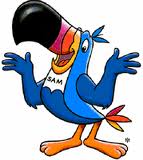- Similarity in the overall impression created by the two marks
- Similarities of the goods and services involved
- Strength of the plaintiff's mark;
- Any evidence of actual confusion by consumers;
- Intent of the defendant in adopting its mark;
- Physical proximity of the goods in the retail marketplace;
- Degree of care likely to be exercised by the consumer; and
- Likelihood of expansion of the product lines.
Now, most of us who have eaten Kellogg's Fruit Loops cereal...or still eat those colorful, sugar-coated rings, are familiar with Toucan Sam. The other mark, though, may not be readily known by many of you, but it is associated with the Maya Archaeology Initiative(MAI). According to its website, MAI's purpose is to "provide educational opportunities and training in Mayan history and culture for Guatemalan young people," "encourage conservation of the Peten rainforest’s animals, plants, and natural resources," "support research in new areas of Maya archaeology," "protect cultural and historical resources," and "help communities better their standards of living." And, by the way, the toucan is native to many countries in Central and South America, including Guatemala.
So, are these marks confusingly similar? Granted, both marks depict a toucan, but the analysis doesn't stop there. Considering the marks represented by each of these marks, Toucan Sam is limited to Fruit Loops. In contrast, the MAI toucan with Mayan archaeological remains incorporated is associated with an educational effort by individuals concerned with Guatemalan history and preservation. As to the strength of the Toucan Sam mark, there's no question that it easily associated with Kellogg's Fruit Loops.
Because each of these marks deals with vastly different markets, one being a specific product and the other more of an educational service unrelated to cereal, Kellogg's will be hard-pressed to find actual evidence of consumer confusion. Understand, the evidence, if available, would have to show that consumers, when they see the MAI image, mistakenly believe it to be associated with Kellogg's and/or Fruit Loops. What was your first impression after seeing the MAI image?
As to the intent of MAI in adopting the mark, certainly it was not to compete or cause confusion with Kellogg. On the contrary, MAI undoubtedly chose their image because Guatemala is a natural habitat for the toucan and is where the Mayan archaelogical remains are located. It is difficult to see some ulterior motive for making this choice....but I could be wrong...
As mentioned earlier, these two marks represent quite different products and services. As a result, ascertaining the level of care a consumer would exercise when evaluating these products/services is rather moot. In fact, it is not likely that consumers are visiting the MAI site looking for breakfast. Further, MAI has not disclosed any plan to expand into the cereal market....but that could be just a major ploy to take Kellogg's consumers right from under their nose!
Of course, you all are free to make your own judgment. What do you think? Toucan or not Toucan?


